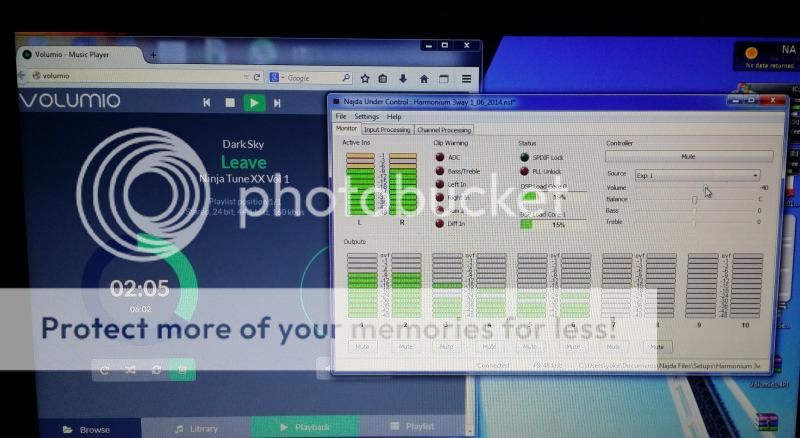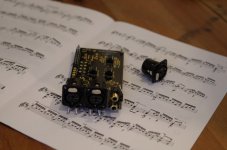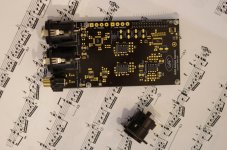Hey Josip,
I had given it a try myself with Volumio and posted a few details here and in the following pages maybe.
It's actually pretty easy once that you have the rPi configured and running. For the wiring, please refer to the Startup Guide. Don't power the rPi from the expansion power lines.
I got the final invoices for the front control board, so I have pricing information. The PCB alone will be only EUR 12. Hopefully I can slip it into an envelope with some cardboard and get decent shipping costs (letter format). PCB size is 260 x 36 mm.
There's been a lot of mechanical work on this board. Note the strange shape is to make space for mounting brackets, should you need that.

The full option is EUR 45. This includes a OLED display (white text), push-buttons with black round caps, transparent round leds with colour when they light on, Vishay IR sensor 38 kHz, Bourns all metal rotary encoder with central push for mute plus the filter discrete components (4 resistors and 2 caps) and a black "aluminum" 30x19mm knob, plus all cables and screws/bolts.
Full option will be delivered unassembled, so you're going to need a soldering iron if you choose this option. Nothing complicated.
I'll post pictures early July. It's nice
@Tuyen, got your message
Nick
I had given it a try myself with Volumio and posted a few details here and in the following pages maybe.
It's actually pretty easy once that you have the rPi configured and running. For the wiring, please refer to the Startup Guide. Don't power the rPi from the expansion power lines.
I got the final invoices for the front control board, so I have pricing information. The PCB alone will be only EUR 12. Hopefully I can slip it into an envelope with some cardboard and get decent shipping costs (letter format). PCB size is 260 x 36 mm.
There's been a lot of mechanical work on this board. Note the strange shape is to make space for mounting brackets, should you need that.

The full option is EUR 45. This includes a OLED display (white text), push-buttons with black round caps, transparent round leds with colour when they light on, Vishay IR sensor 38 kHz, Bourns all metal rotary encoder with central push for mute plus the filter discrete components (4 resistors and 2 caps) and a black "aluminum" 30x19mm knob, plus all cables and screws/bolts.
Full option will be delivered unassembled, so you're going to need a soldering iron if you choose this option. Nothing complicated.
I'll post pictures early July. It's nice
@Tuyen, got your message
Nick
Hi Sean,
No there's not really the plan of having panels manufactured. But I'll make the files available so that you could customize them to your taste and send them to either a local manufacturer or a company like Schaeffer in Germany or FrontPanelExpress in the US (they are expensive however).
Or there could be a GP if someone knows a manufacturer who can produce small series at a decent price. The above Schaeffer and FrontPanelExpress are very practical but they don't offer substantial discounts on larger orders (10% on 5-9 units, 20% on 10-19 units, 30% on 20-29 units) so they are fine only if you want your very own unique design and you're ready to pay for that.
Nick
No there's not really the plan of having panels manufactured. But I'll make the files available so that you could customize them to your taste and send them to either a local manufacturer or a company like Schaeffer in Germany or FrontPanelExpress in the US (they are expensive however).
Or there could be a GP if someone knows a manufacturer who can produce small series at a decent price. The above Schaeffer and FrontPanelExpress are very practical but they don't offer substantial discounts on larger orders (10% on 5-9 units, 20% on 10-19 units, 30% on 20-29 units) so they are fine only if you want your very own unique design and you're ready to pay for that.
Nick
Raspberry Pi/Volumio and Najda
it works
haven't do any listening but it plays music
mini coax for connexion, connected as ;
PI______________________________ NAJDA
pin 3 PCM_CLK=BCK_______________pin 23 CKR / pin 24 for GND
pin 4 PCM_FS=LRCK_______________pin 25 FSR / pin 26 for GND
pin 6 PCM_DOUT=DATA____________pin 1 LINE 1 / pin 2 for GND
pin 7 and 8 for GND
and have to short pin 13 IS_EXT1 to 10 DGND on NAJDA


it works
haven't do any listening but it plays music
mini coax for connexion, connected as ;
PI______________________________ NAJDA
pin 3 PCM_CLK=BCK_______________pin 23 CKR / pin 24 for GND
pin 4 PCM_FS=LRCK_______________pin 25 FSR / pin 26 for GND
pin 6 PCM_DOUT=DATA____________pin 1 LINE 1 / pin 2 for GND
pin 7 and 8 for GND
and have to short pin 13 IS_EXT1 to 10 DGND on NAJDA


Hi to all,
last week F2a11 and I tried to see if there is a difference in sound quality (SQ) by replacing the LM833 Opamps of the Outputs from Najda board. We tried the LM 4562, LM 2604 and the Opa 627 ( 2 of them on a PCB adapter). Our audio system is a stereo horn arrangement with 3 drivers per channel.
We know that just replacing the OPamps is not the absolute correct way, because we did not adapt the peripheral parts connected to the Opamps to optimize their working point.
Replacement had an influence on sound quality ( not a great one) and here are our (perhaps subjective) results that we perceived:
1. In our opinion the original LM833 in the Najda board works very fine. Tight bass, well resolved mids and highs, perhaps no so much microdetails in the highs, but a warm and a very analoglike reproduction.
2. Replacement by LM4562: The bass reproduction was not so tight, a litte bit better resoultion of the highs, sometimes a little bit harsh, overall impression was that SQ looses the somewhat warm, analog character, a little bit cool reproduction.
3. Replacement by LM 2604: Almost the same as with the LM 4562, more analytical.
4. Replacement by OPA 627: Again a wonderful bass reproduction, very tight ( similar to the LM 833), but the best resolution of the mids and highs, a little more microdetails in the highs, very dynamic, the analog character is still there.
In summary: The differences heared between the LM833 and the other OPAs, although perceivable, were not large, and also depend on great extent of the music which is reproduced. The one we prefered was the OPA 627 because of the little more resolution of the highs, but could also perfectly live with the LM833. Congratulations Nick!
Just tried OPA627 in mine and I agree with your observations. A little more clarity and crispness in the upper registers, most noticeable is that the bass seems more powerful and everything seems to be a bit more dynamic.
rPi / volumio on Najda via I2S
Hi...sorry don't know where to post this...but maybe someone could help...
As mantion before...
I have conected rPi/Volumio 1.4 on Najda via I2S
- the thing is that i have mono sound (left chanel) on Najda L/R chanels with flac files (normal CD, no high resolution)
- but have stereo with mp3 and WAV files
Does any one have any idea what to do to have stereo with flac files...or to point me to some combination that works with rPi and Najda ?
tnx
Hi...sorry don't know where to post this...but maybe someone could help...
As mantion before...
I have conected rPi/Volumio 1.4 on Najda via I2S
- the thing is that i have mono sound (left chanel) on Najda L/R chanels with flac files (normal CD, no high resolution)
- but have stereo with mp3 and WAV files
Does any one have any idea what to do to have stereo with flac files...or to point me to some combination that works with rPi and Najda ?
tnx
Hi Josip,
I'm afraid I cannot help you much on this issue.
What I can say is that if you have stereo sound with some file formats, and only mono with some others, then the problem doesn't lie in the connections between the rPi and the Najda.
It's probably a Volumio configuration issue, and I'd recommend you post your question on the Volumio forum.
Cheers,
Nick
I'm afraid I cannot help you much on this issue.
What I can say is that if you have stereo sound with some file formats, and only mono with some others, then the problem doesn't lie in the connections between the rPi and the Najda.
It's probably a Volumio configuration issue, and I'd recommend you post your question on the Volumio forum.
Cheers,
Nick
Hi Nick,
i think i have a hardware problem with Najda. Since i´ve changed the display from VFD to OLED, something "buzzes" on the Najda board. It´s a high frequency buzz, sounds like a cheap SPS power supply. I´ve tried another OLED display with same result :-(
I´ve also tried a SPS power supply, i have now a regulated analog one with 2 transformators and 4 regulators. The power supply didn´t change the "buzz" at all...
Is there something I can try before changing the whole DSP?
claudius
i think i have a hardware problem with Najda. Since i´ve changed the display from VFD to OLED, something "buzzes" on the Najda board. It´s a high frequency buzz, sounds like a cheap SPS power supply. I´ve tried another OLED display with same result :-(
I´ve also tried a SPS power supply, i have now a regulated analog one with 2 transformators and 4 regulators. The power supply didn´t change the "buzz" at all...
Is there something I can try before changing the whole DSP?
claudius
Hi Claudius,
I can't see the connection between changing the display and a buzzing sound.
What I can suggest:
- Isolate as much as you can the Najda from the rest of your system.
- Disconnect the USB control cable.
- Try a full SPDIF audio path with a pass-through preset. This one for sure should be clean.
- Keep the SPDIF out, but with an analogue input. If this one is buzzing, then you know the problem is probably lying on the analogue input path.
- Try the other combination (SPDIF in, analogue out)
- Inspect the connections between the Najda board and your sockets. I remember you ordered a board with unassembled sockets, is that right?
That's what I can think of for now. Keep us posted.
Nick
I can't see the connection between changing the display and a buzzing sound.
What I can suggest:
- Isolate as much as you can the Najda from the rest of your system.
- Disconnect the USB control cable.
- Try a full SPDIF audio path with a pass-through preset. This one for sure should be clean.
- Keep the SPDIF out, but with an analogue input. If this one is buzzing, then you know the problem is probably lying on the analogue input path.
- Try the other combination (SPDIF in, analogue out)
- Inspect the connections between the Najda board and your sockets. I remember you ordered a board with unassembled sockets, is that right?
That's what I can think of for now. Keep us posted.
Nick
Alright, got you now 
That's pretty weird. If you put back the VFD display, is the board still buzzing? And if you have no display installed at all?
I've already seen a 'singing cap' on a previous job. It was a small SMD part and I literally needed to put my ear above the cap in order to hear the hiss.
The display is powered from the digital 5V, there's no regulator here. Nothing in the vicinity of the DSP is connected to that same 5V. The DSP itself gets the power from the 3.3V and 1.2V regulators. These are located near the edge of the PCB, between the 2 screw terminal blocks.
Can you locate more precisely where the noise is coming from?
That's pretty weird. If you put back the VFD display, is the board still buzzing? And if you have no display installed at all?
I've already seen a 'singing cap' on a previous job. It was a small SMD part and I literally needed to put my ear above the cap in order to hear the hiss.
The display is powered from the digital 5V, there's no regulator here. Nothing in the vicinity of the DSP is connected to that same 5V. The DSP itself gets the power from the 3.3V and 1.2V regulators. These are located near the edge of the PCB, between the 2 screw terminal blocks.
Can you locate more precisely where the noise is coming from?
Hi Josip,
I'm afraid I cannot help you much on this issue.
What I can say is that if you have stereo sound with some file formats, and only mono with some others, then the problem doesn't lie in the connections between the rPi and the Najda.
It's probably a Volumio configuration issue, and I'd recommend you post your question on the Volumio forum.
Cheers,
Nick
Think I solve this...
have set resampling inside volumio player to 32 bit 44.1khz
Now I have stereo with flac files...
have test only two albums...but...I hope that's it...
- Home
- Source & Line
- Digital Line Level
- DSP Xover project (part 2)



